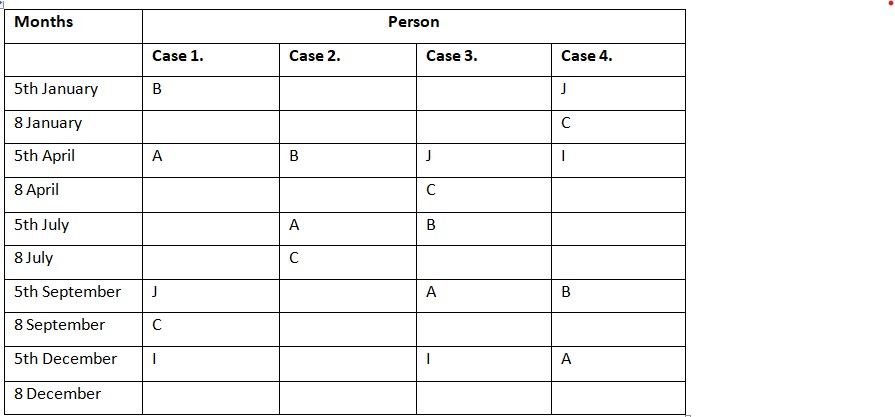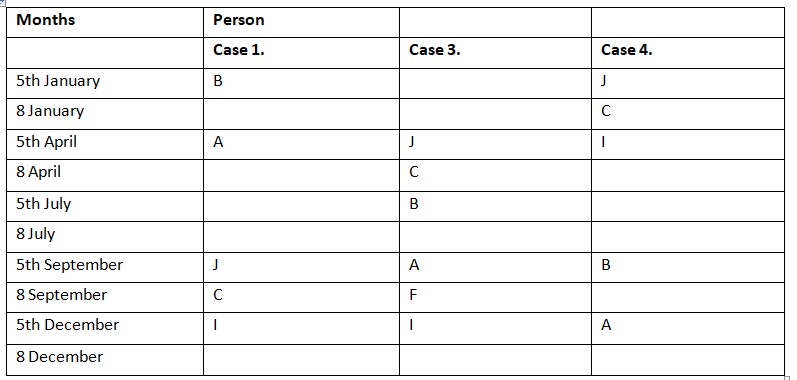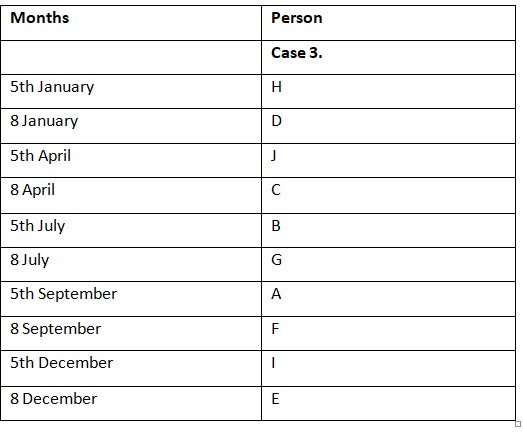Question
Who among the following person attends seminar on
8th of January? Study the following information carefully and answer the below questions. Ten persons namely –A, B, C, D, E, F, G, H, I, and J attend a seminar event in five different months viz.- January, April, July, September, December. Seminar in each month was scheduled on the 5thrd and 8th of the month. All the information is not necessary in the same order. The number of persons is attending a seminar after A is the same as the number of persons is attending the seminar before C. A attends seminar two months after B, who attends the seminar on an odd date. C and J attend the seminar in the same month. The number of persons is attending the seminar between J and B is the same as the number of persons is attending the seminar between A and I. The number of persons attending the seminar between F and C is one less than the number of persons is attending the seminar between H and G. F attends seminar three months before I, who attends seminar in one of the months has 31 days. G attends seminar on the 8th of the month but not in January. H and D attend seminars in the same month. At least two persons attend the seminar between E and A.Solution
The number of persons is attending a seminar after A is the same as the number of persons is attending the seminar before C. A attends seminar two months after B, who attends the seminar on an odd date. C and J attend the seminar in the same month. We will have four cases: If B attends seminar on 5th January, then A will attend on 5th April. C will attend on 8 September and J will attend on 5th September. If B attends seminar on 5th April, then A will attend on 5th July. C will attend on 8 July but we do not have dates for J. If B attends seminar on 5th July, then A will attend on 5th September. C will attend on 8 April and J will attend on 5th April. If B attends seminar on 5th September, then A will attend on 5th December. C will attend on 8 January and J will attend on 5th January.  The number of persons is attending the seminar between J and B is the same as the number of persons is attending the seminar between A and I. In case 1, there are five person between B and J. So, I attends seminar on 5th December. In case 3, there is one person between B and J. So, I attends seminar on 5th December. In case 4, there are five person between B and J. So, I attends seminar on 5th April. F attends seminar three months before I, who attends seminar in one of the months has 31 days. Case 1 and 4 will get discarded as we know that I attends the seminar in December and F should have attended in September. In case 3, F attends seminar on 8 September.
The number of persons is attending the seminar between J and B is the same as the number of persons is attending the seminar between A and I. In case 1, there are five person between B and J. So, I attends seminar on 5th December. In case 3, there is one person between B and J. So, I attends seminar on 5th December. In case 4, there are five person between B and J. So, I attends seminar on 5th April. F attends seminar three months before I, who attends seminar in one of the months has 31 days. Case 1 and 4 will get discarded as we know that I attends the seminar in December and F should have attended in September. In case 3, F attends seminar on 8 September.  At least two persons attend the seminar between E and A. So, E attends seminar on 8 December. G attends seminar on the 8th of the month but not in January. Now it is clear that G attends the seminar on 8 July. The number of persons attending the seminar between F and C is one less than the number of persons is attending the seminar between H and G . H and D attend seminars in the same month. We know that three person are there between F and C. It means that there would have been four person between G and H. So, H and D attend seminar on 5th January and 8 January respectively. Final arrangement as shown below:
At least two persons attend the seminar between E and A. So, E attends seminar on 8 December. G attends seminar on the 8th of the month but not in January. Now it is clear that G attends the seminar on 8 July. The number of persons attending the seminar between F and C is one less than the number of persons is attending the seminar between H and G . H and D attend seminars in the same month. We know that three person are there between F and C. It means that there would have been four person between G and H. So, H and D attend seminar on 5th January and 8 January respectively. Final arrangement as shown below: 
From which part of Earth's interior does Magma originate?
Which city hosted the World Telecommunication Standardization Assembly (WTSA) 2024 for the first time in India and the Asia-Pacific?
What was India's Current Account Deficit (CAD) as a percentage of GDP in Q1 FY25?
What is used to identify users who come back to a webpage?
Kolathunadu, Valluvanad and Thekkumkoor were ancient small-time kingdoms in which state of India?
An arrangement between GOI and RBI to mop up the excess liquidity generated on account of higher capital inflows is called –
Recently, who has been appointed as new finance secretary of India?
Who is appointed as the next High Commissioner of India to the United Kingdom?
Which one of the following states Gulf of Khambhat is situated?
The Rawat Nach Mahotsav, a folk dance festival, is celebrated by which community?
Relevant for Exams:


